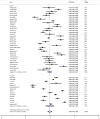The prognosis of mild cognitive impairment: A systematic review and meta-analysis
- PMID: 40078377
- PMCID: PMC11898010
- DOI: 10.1002/dad2.70074
The prognosis of mild cognitive impairment: A systematic review and meta-analysis
Erratum in
-
Correction to "The prognosis of mild cognitive impairment: A systematic review and meta-analysis".Alzheimers Dement (Amst). 2025 Jul 18;17(3):e70150. doi: 10.1002/dad2.70150. eCollection 2025 Jul-Sep. Alzheimers Dement (Amst). 2025. PMID: 40689335 Free PMC article.
Abstract
Introduction: Knowledge gaps remain about the prognosis of mild cognitive impairment (MCI). Conversion rates to dementia vary widely, and reversion to normal cognition has gained attention. This review updates evidence on MCI conversion risk and probability of stability and reversion.
Methods: We searched databases for studies on MCI prognosis with ≥3 years of follow-up, established criteria for MCI and dementia, and performed a meta-analysis using a random-effects model to assess conversion risk, reversion, and stability probability. Meta-regressions identified sources of heterogeneity and guided subgroup analysis.
Results: From 89 studies (mean follow-up: 5.2 years), conversion risk was 41.5% (38.3%-44.7%) in clinical and 27.0% (22.0%-32.0%) in population-based studies, with Alzheimer's dementia as the most common outcome. Stability rates were 49.3% (clinical) and 49.8% (population). Reversion was 8.7% (clinical) and 28.2% (population).
Discussion: Our findings highlight higher conversion in clinical settings and 30% reversion in population studies, calling for sustainable care pathway development.
Highlights: Prognosis for mild cognitive impairment (MCI) varies by setting; dementia risk is higher and the probability of reversion is lower in clinical-based studies.In both clinical and population settings, cognitive stability is ≈50%.A reorganization of health services could ensure sustainable care for individuals with MCI.Significant heterogeneity in MCI studies impacts data interpretation; follow-up length is crucial.Long-term prognosis studies on MCI in low- and middle-income countries are urgently needed.
Keywords: Alzheimer's disease; MCI; brain health; cognitive decline; conversion; decentralization; dementia; functional ability; meta‐analysis; primary health care; quality of care; reversion; sustainability.
© 2025 The Author(s). Alzheimer's & Dementia: Diagnosis, Assessment & Disease Monitoring published by Wiley Periodicals, LLC on behalf of Alzheimer's Association.
Conflict of interest statement
F.T. received honoraria from Biogen for lectures, presentations, speakers’ bureaus, manuscript writing, or educational events. The other authors have no conflicting interests relevant to the manuscript. Author disclosures are available in the Supporting Information.
Figures





References
-
- World Health Organization . Global strategy and action plan on ageing and health. World Health Organization; 2017. Licence: CC BY‐NC‐SA 3.0 IGO.
-
- Crook T, Bahar H, Sudilovsky A. Age‐associated memory impairment: diagnostic criteria and treatment strategies. Int J Neurol. 1987;21‐22:73‐82. - PubMed
-
- Levy R. Aging‐associated cognitive decline. Working Party of the International Psychogeriatric Association in collaboration with the World Health Organization. Int Psychogeriatr. 1994;6(1):63‐68. - PubMed
-
- American Psychiatric Association . Diagnostic and Statistical Manual of Mental Disorders DSM–5. 5th ed.; American Psychiatric Association; 2013.
Publication types
LinkOut - more resources
Full Text Sources
